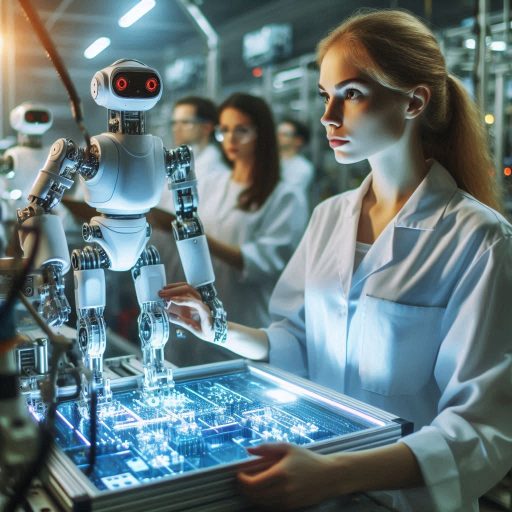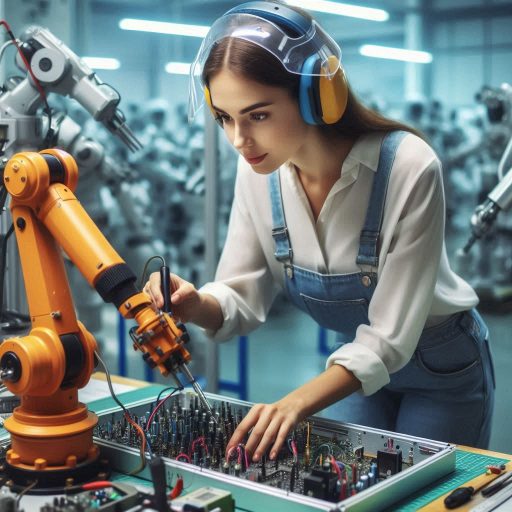Introduction
Robotics engineering is a rapidly evolving field dedicated to designing and developing robots capable of performing tasks autonomously.
This interdisciplinary area merges mechanical engineering, electrical engineering, and computer science to create systems that can carry out a wide range of functions, from industrial automation to personal assistance.
As robotics technology advances, patents and inventions become increasingly important.
Patents provide legal protection for new technologies, ensuring that inventors can secure exclusive rights to their innovations.
This legal framework encourages further research and development by offering incentives for creativity and technological breakthroughs.
In robotics, patents cover a diverse range of inventions, including autonomous navigation systems, advanced manipulation techniques, and novel sensor technologies.
These patents safeguard the intellectual property of innovators and help drive progress by enabling others to build on these foundational technologies.
For example, patents related to robotic arms and grippers have revolutionized manufacturing processes, while innovations in sensor technology have enhanced robots’ ability to interact with their environments.
This blog will delve into key patents and inventions that have significantly impacted robotics engineering.
We will explore how these innovations have shaped the field and examine their implications for the future of robotics technology.
History of Robotics Engineering
The Origins of Robotics Engineering
Robotics engineering traces its origins back to ancient times when inventors created mechanical devices to perform simple tasks.
Early examples include automata, which were mechanical devices designed to mimic human or animal movements.
The modern concept of robots emerged in the early 20th century, notably with Karel ?apek’s 1920 play R.U.R., which introduced the term “robot.”
This play depicted artificial workers, laying the conceptual groundwork for robotics engineering as we know it today.
Key Milestones in the Development of Robotics Technology
Robotics engineering made significant strides in the mid-20th century with the advent of industrial robots.
A major milestone occurred in 1961 when Unimation introduced the Unimate, the first industrial robot used for automotive assembly.
This development marked the beginning of robotics in manufacturing.
Another breakthrough came in 1973 with the Stanford Arm, designed by Victor Scheinman.
This robotic arm featured programmable control, greatly enhancing automation capabilities.
In the 1980s, advances in computer technology led to the development of autonomous robots, exemplified by MIT’s autonomous mobile robot.
The introduction of Boston Dynamics’ BigDog in 2005 further demonstrated the potential for robots to navigate complex environments, showcasing advancements in robotic mobility and stability.
Importance of Historical Inventions and Patents in Shaping the Field
Historical inventions and patents have been pivotal in shaping robotics engineering.
Patents protect key technologies, such as robotic arms, sensors, and autonomous navigation systems, fostering innovation by securing intellectual property rights.
For instance, the patent for the first industrial robot, filed by George Devol and Joseph Engelberger in the 1950s, laid the foundation for the robotics industry.
Similarly, patents related to robotic grippers and manipulation systems have enabled more precise and versatile robotic applications.
Understanding these historical milestones and patents provides insight into how foundational technologies have evolved and influenced modern robotics.
These innovations continue to drive the field forward, highlighting the importance of protecting and building upon past achievements.
Key Patents in Robotics Engineering
Significance of Patents in Protecting Intellectual Property
Patents play a crucial role in protecting intellectual property, particularly in the field of robotics engineering.
They grant inventors exclusive rights to their innovations, preventing others from using, making, or selling their ideas without permission.
This legal protection incentivizes creativity and investment in new technologies by ensuring that inventors can benefit from their inventions.
For robotics engineers, patents are essential for safeguarding groundbreaking technologies and maintaining a competitive edge in the industry.
Landmark Patents in Robotics
Several landmark patents have significantly advanced the field of robotics, particularly in sensors, actuators, and control systems.
One notable example is the patent for the piezoelectric sensor, granted in the early 1960s.
This invention allowed for the development of highly sensitive sensors that could detect minute changes in the environment.
Piezoelectric sensors are now integral to many robotic systems, enabling precise measurements and control.
Another key patent is related to the development of hydraulic actuators.
Patented in the 1970s, these actuators provided robots with greater strength and flexibility.
Hydraulic actuators use fluid pressure to produce movement, allowing robots to perform tasks that require significant force.
This innovation paved the way for more powerful and versatile robotic systems, particularly in industrial applications.
The patent for the PID (Proportional-Integral-Derivative) control algorithm, granted in the 1950s, has also had a profound impact on robotics.
The PID controller is fundamental in robotics for maintaining desired outputs by adjusting inputs based on feedback.
This technology allows robots to perform precise and stable movements, making it essential for tasks requiring high accuracy.
Influence on the Evolution of Robotics Technology
These landmark patents have profoundly influenced the evolution of robotics technology.
The piezoelectric sensor patent enabled robots to interact with their environment with unprecedented sensitivity, leading to advancements in automation and precision tasks.
Hydraulic actuators revolutionized the capabilities of robots, allowing them to perform heavy-duty operations and improve their efficiency in industrial settings.
The PID control algorithm patent has been instrumental in refining robotic control systems.
By providing a framework for feedback-based adjustments, the PID controller has improved the accuracy and reliability of robotic movements.
This innovation has made it possible for robots to perform complex tasks with greater consistency and precision.
Overall, these patents have driven the development of more advanced and capable robotic systems.
They have laid the foundation for subsequent innovations and applications in robotics, from manufacturing to healthcare.
Patents continue to play a vital role in fostering innovation, protecting intellectual property, and shaping the future of robotics technology.
Read: Sustainable Wastewater Treatment Methods
Inventions in Robotics Engineering
Explore Groundbreaking Inventions in Robotics
Robotics engineering has seen remarkable inventions that have revolutionized various fields.
One standout is the robotic arm, which has transformed manufacturing.
Engineers designed these arms to handle precise tasks, such as welding and assembly, with high accuracy.
Their ability to perform repetitive tasks with consistent precision has boosted productivity in factories.
Autonomous vehicles represent another groundbreaking invention.
Engineers created these self-driving cars to navigate without human input.
Equipped with advanced sensors and AI, autonomous vehicles can safely transport passengers while reducing human error.
They have the potential to greatly improve road safety and efficiency in transportation.
Exoskeletons are also a significant innovation in robotics.
These wearable devices assist individuals with mobility impairments and enhance physical capabilities.
Engineers designed exoskeletons to support and amplify human movement, aiding those with disabilities and workers in physically demanding jobs.
Impact on Various Industries
The robotic arm has had a profound impact on manufacturing.
Factories use these arms for tasks like assembly, painting, and packaging.
Their precision and efficiency have lowered production costs and increased product quality.
Autonomous vehicles are reshaping the transportation industry.
These vehicles can reduce traffic accidents caused by human error.
They also offer the potential for more efficient use of roadways and improved public transportation systems.
In healthcare, exoskeletons are making a difference.
They help patients with mobility issues regain movement and independence.
For workers, exoskeletons reduce the strain of heavy lifting and repetitive tasks, preventing injuries.
Innovative Features and Contributions
Robotic arms feature advanced control systems that allow them to perform complex tasks with high precision.
Their programmable nature enables customization for different manufacturing processes, enhancing flexibility and productivity.
Autonomous vehicles rely on a combination of sensors, cameras, and AI algorithms to navigate safely.
These technologies enable them to detect obstacles, follow traffic rules, and adapt to changing conditions.
Their innovative features promise to transform how we travel and interact with transportation systems.
Transform Your Career Today
Unlock a personalized career strategy that drives real results. Get tailored advice and a roadmap designed just for you.
Start NowExoskeletons incorporate lightweight materials and adaptive support systems to enhance user comfort and effectiveness.
They provide real-time feedback and adjust support levels based on the user‘s needs.
This innovation not only aids physical rehabilitation but also improves the quality of life for users.
These inventions highlight the incredible advancements in robotics engineering.
They demonstrate how innovative technologies can address real-world challenges and create significant benefits across various industries.
As robotics continues to evolve, its contributions to society will undoubtedly grow, further enhancing our daily lives and shaping the future.
Read: Tips for Writing Environmental Engineering Reports
Technological Advancements in Robotics
Recent Advancements in Robotics Technology, Such as Artificial Intelligence, Machine Learning, and Computer Vision
Recent advancements in robotics technology, such as artificial intelligence (AI), machine learning, and computer vision, have dramatically transformed the field.
AI enables robots to process vast amounts of data, making them more intelligent and adaptable.
Machine learning allows robots to learn from experience and improve their performance over time.
Computer vision provides robots with the ability to perceive and understand their environment through visual input.
These technologies are driving the evolution of robotics, enhancing their functionality and capabilities.
How These Advancements Have Led to the Development of More Sophisticated Robotic Systems
The integration of AI, machine learning, and computer vision has led to the creation of more sophisticated robotic systems.
AI-driven algorithms enable robots to perform complex tasks with high precision.
For example, autonomous vehicles use AI to navigate and make decisions based on real-time data.
Machine learning enhances robots‘ ability to adapt to new tasks and environments, improving their versatility.
Computer vision advancements allow robots to interact more effectively with their surroundings, such as recognizing objects and navigating through dynamic spaces.
These improvements have broadened the scope of robotic applications in various industries, from healthcare to manufacturing.
Key Patents That Have Supported These Technological Advancements
Key patents have significantly contributed to these technological advancements.
IBM’s Watson, a pioneering AI system, exemplifies how AI can revolutionize robotics.
Watson‘s technology supports various robotic applications, including customer service and healthcare.
Google‘s TensorFlow is a crucial machine learning framework that has advanced deep learning capabilities in robotics.
TensorFlow‘s algorithms enable robots to perform tasks such as image recognition and natural language processing.
Microsoft‘s Kinect sensor patent has innovated motion sensing and gesture recognition, which has been adapted for use in robotics.
Intel‘s RealSense technology has advanced depth sensing and spatial awareness, enhancing robots’ ability to interact with their environment.
These patents have been instrumental in driving the progress of robotics technology, shaping the future of robotic systems.
Read: Public Health and Environmental Engineering

See Related Content: How Geotechnical Engineers Support Infrastructure
Collaboration and Innovation in Robotics Engineering
Role of Collaboration Among Researchers, Engineers, and Inventors in Advancing Robotics Technology
Collaboration among researchers, engineers, and inventors is essential for driving advancements in robotics technology.
This interdisciplinary teamwork combines various areas of expertise, enabling the development of innovative solutions that individual efforts alone might not achieve.
Researchers contribute their deep theoretical knowledge, engineers bring practical design and implementation skills, and inventors offer creative insights and problem-solving abilities.
Together, these professionals push the boundaries of what is possible in robotics, accelerating progress and creating groundbreaking technologies.
For instance, robotics development often requires the integration of complex systems, such as artificial intelligence, machine learning, and advanced sensors.
Researchers might focus on developing algorithms for intelligent decision-making, while engineers design the physical systems to house and deploy these algorithms.
Inventors might identify novel applications or improvements that enhance the functionality of the robots.
The combined efforts of these professionals result in more robust and versatile robotic systems that can tackle a wide range of tasks and challenges.
The role of collaboration extends beyond individual projects.
It also involves sharing resources, data, and insights, which fosters a more innovative environment.
Joint research efforts and partnerships between academic institutions, industry leaders, and government agencies often lead to significant technological breakthroughs.
Such collaborations create an ecosystem where knowledge flows freely, and advancements in one area can quickly benefit others.
Examples of Successful Collaborations That Have Resulted in Significant Inventions and Patents
Several high-profile collaborations exemplify how teamwork leads to significant inventions and patents in robotics.
One prominent example is the partnership between MIT and Boston Dynamics.
Researchers at MIT developed foundational technologies for advanced robotics, which Boston Dynamics then refined and commercialized.
This collaboration produced robots like Spot and Atlas, known for their exceptional mobility and versatility.
These robots represent major milestones in robotics engineering and have led to numerous patents that advance the field.
Another notable collaboration involves Carnegie Mellon University and Google.
This partnership focused on developing autonomous vehicles, a complex field requiring expertise in robotics, machine learning, and automotive engineering.
Researchers and engineers from both organizations worked together to create technologies that enable self-driving cars to navigate safely and efficiently.
Their joint efforts resulted in numerous patents and have had a profound impact on the future of transportation.
International initiatives also demonstrate the power of collaboration.
The European Union’s Horizon 2020 program, for example, brings together researchers and engineers from across Europe to address challenges in robotics and automation.
Projects under this program have led to innovations such as robotic exoskeletons and advanced surgical robots.
These collaborations showcase how pooling resources and knowledge on a global scale can lead to significant advancements in robotics technology.
Importance of Fostering Innovation and Sharing Knowledge in the Field of Robotics Engineering
Fostering innovation and sharing knowledge are critical for the advancement of robotics engineering.
An open and collaborative environment accelerates technological development and helps overcome complex challenges.
When researchers, engineers, and inventors share their findings and work together, they build on each other‘s successes and address obstacles more effectively.
Sharing knowledge prevents duplication of effort and promotes the rapid dissemination of new technologies.
It also facilitates the exchange of best practices and lessons learned, which can improve the quality and efficiency of robotic systems.
This collaborative approach ensures that advancements are not confined to isolated teams but are accessible to the broader robotics community.
Furthermore, fostering a culture of innovation encourages continuous improvement and exploration of new ideas.
It motivates professionals to think creatively and push the boundaries of what is possible.
As the field of robotics evolves, maintaining a collaborative spirit and emphasizing the importance of knowledge sharing will be key to driving future breakthroughs and shaping the next generation of robotics technologies.
Read: Environmental Engineering and Marine Conservation
See Related Content: Environmental Technician’s Role in Emergency Response
Ethical and Legal Considerations in Robotics
Addressing Ethical Issues Related to Robotics Technology
Robotics technology presents several ethical challenges.
One major concern is job displacement.
As robots take on more tasks, they can replace human workers in various industries.
This shift can lead to significant economic and social impacts.
Privacy concerns also arise with robotics technology.
Robots often collect and analyze vast amounts of data.
Without proper safeguards, this data could be misused or accessed by unauthorized parties.
Ensuring robust data protection measures is crucial to addressing these concerns.
Autonomous weapon systems are another ethical issue.
These systems, if misused, can cause harm and escalate conflicts.
Establishing clear regulations is essential to prevent their misuse in warfare or violence.
Importance of Ethical Guidelines and Regulations
Ethical guidelines and regulations are vital for the responsible development of robotics technology.
They provide a framework for ensuring that innovations are used ethically and do not harm society.
Without these guidelines, the rapid advancement of robotics could lead to unintended consequences.
Regulations help ensure that robotics technology is developed with respect for human rights and societal values.
They also promote transparency and accountability in the design and deployment of robotic systems.
Establishing and adhering to these standards helps build public trust in robotics technology.
Role of Patents in Promoting Ethical Practices
Patents play a crucial role in promoting ethical practices in robotics.
They protect intellectual property and prevent unauthorized use of inventions.
By securing patents, inventors can control how their technology is used and ensure it aligns with ethical standards.
Patents also contribute to responsible development by encouraging innovation within legal and ethical boundaries.
They prevent misuse of technology by restricting access to patented inventions without proper authorization.
This protection helps to maintain high ethical standards and prevents exploitation.
Transform Your Career Today
Unlock a personalized career strategy that drives real results. Get tailored advice and a roadmap designed just for you.
Start NowFurthermore, patents can support ethical practices by requiring detailed disclosures of how technology works.
This transparency allows for better scrutiny and accountability, reducing the risk of misuse.
In summary, addressing ethical issues in robotics requires careful consideration of job displacement, privacy, and autonomous weapons.
Ethical guidelines and regulations are essential to ensure responsible development.
Patents play a significant role in promoting ethical practices and protecting inventions from misuse.
By addressing these aspects, we can harness robotics technology for positive societal impact.
Conclusion
The blog post highlighted the significance of key patents and inventions in robotics engineering, showcasing the innovative strides made in the field.
These inventions have paved the way for advancements in automation, artificial intelligence, and more.
The impact of patents and inventions on robotics engineering cannot be overstated.
They have revolutionized industries, improved efficiency, and enhanced productivity.
Without these key innovations, the field of robotics would not have progressed as rapidly as it has today.
As we look to the future, it is essential to continue exploring key patents and inventions in robotics to drive continued innovation and advancement.
By building upon existing technologies and developing new solutions, we can further push the boundaries of what is possible in robotics engineering.
Overall, patents and inventions play a crucial role in shaping the landscape of robotics engineering, driving progress and unlocking new possibilities.
We must continue to support research and development efforts in this field to ensure that we stay at the forefront of technological innovation.




